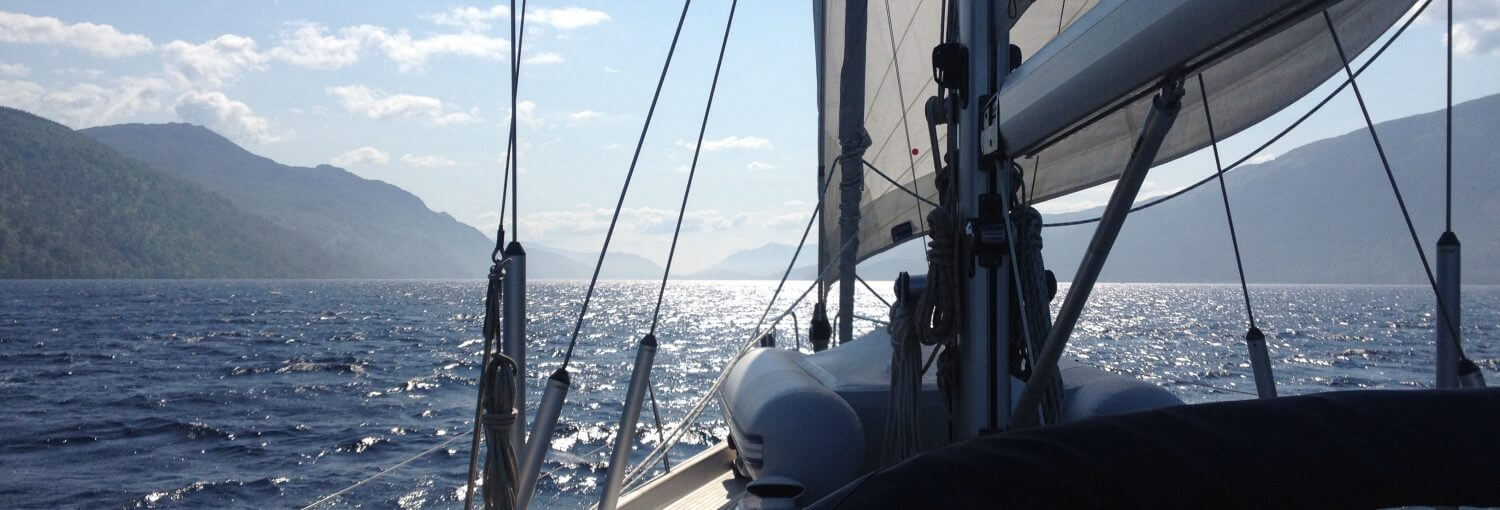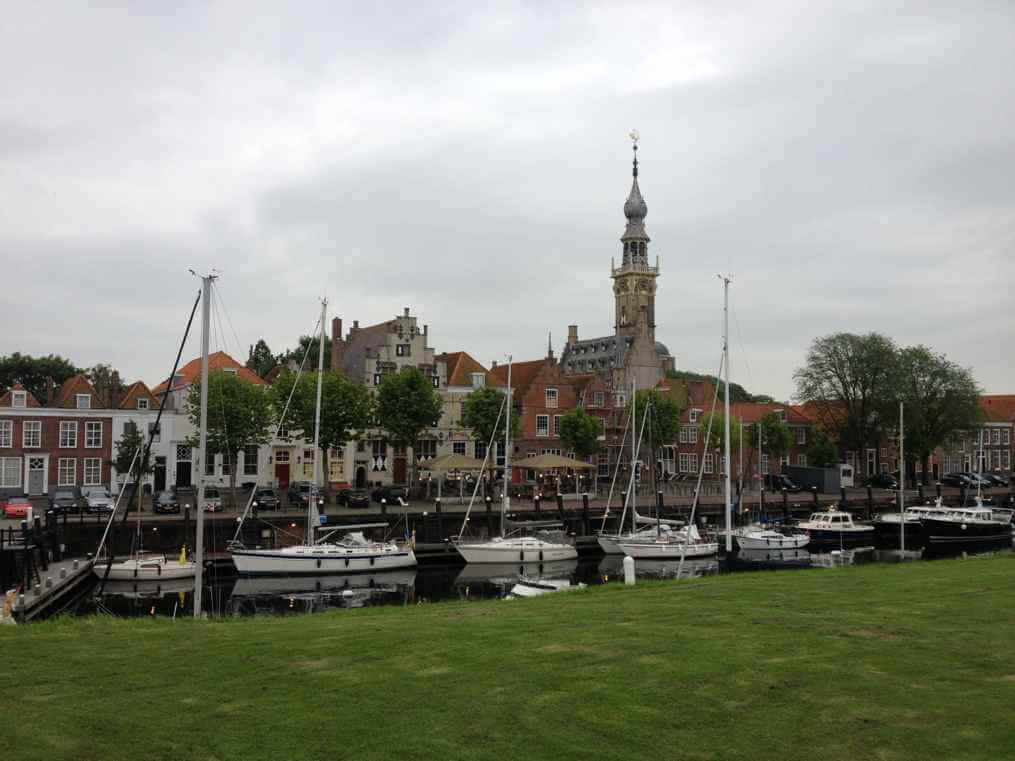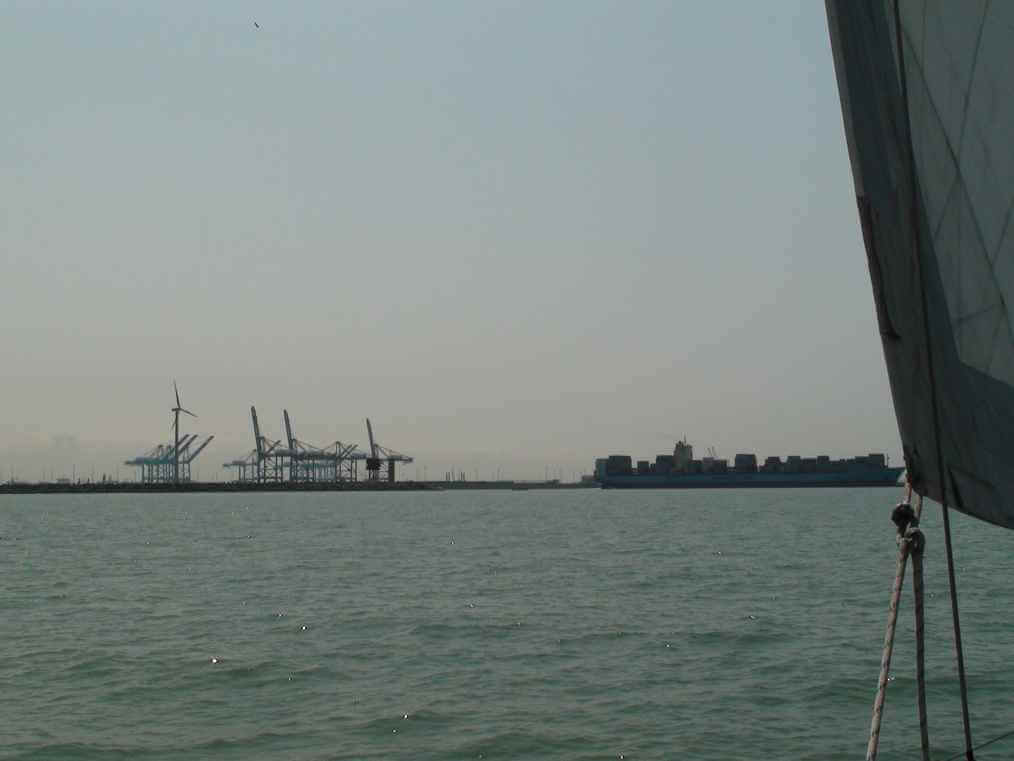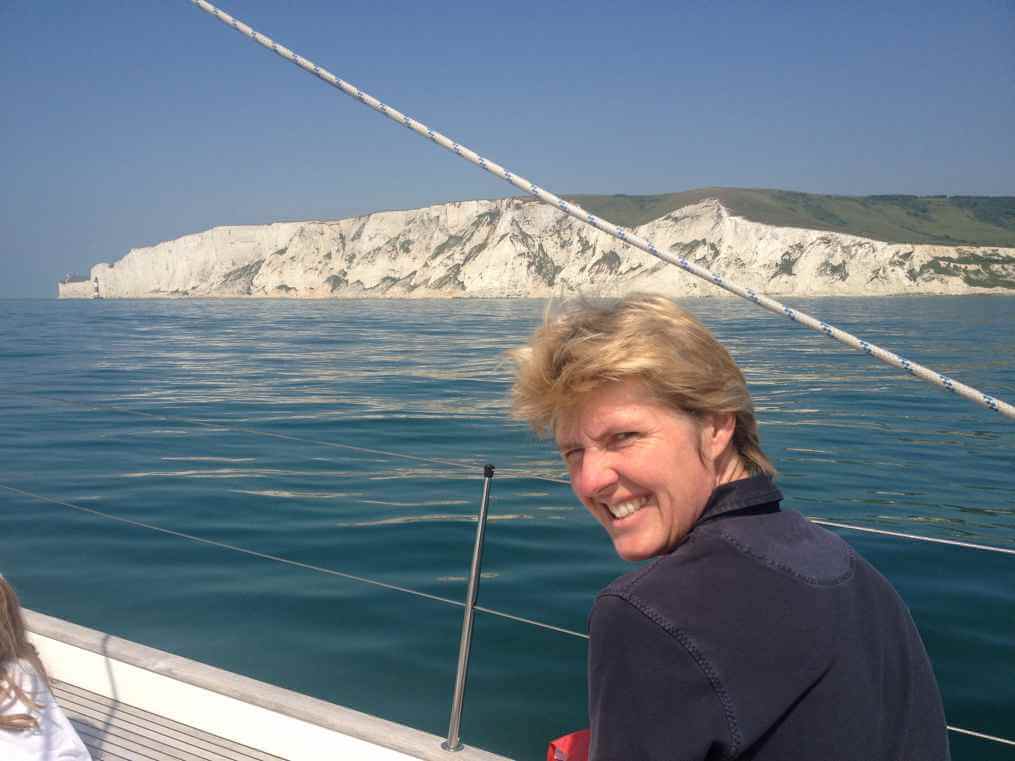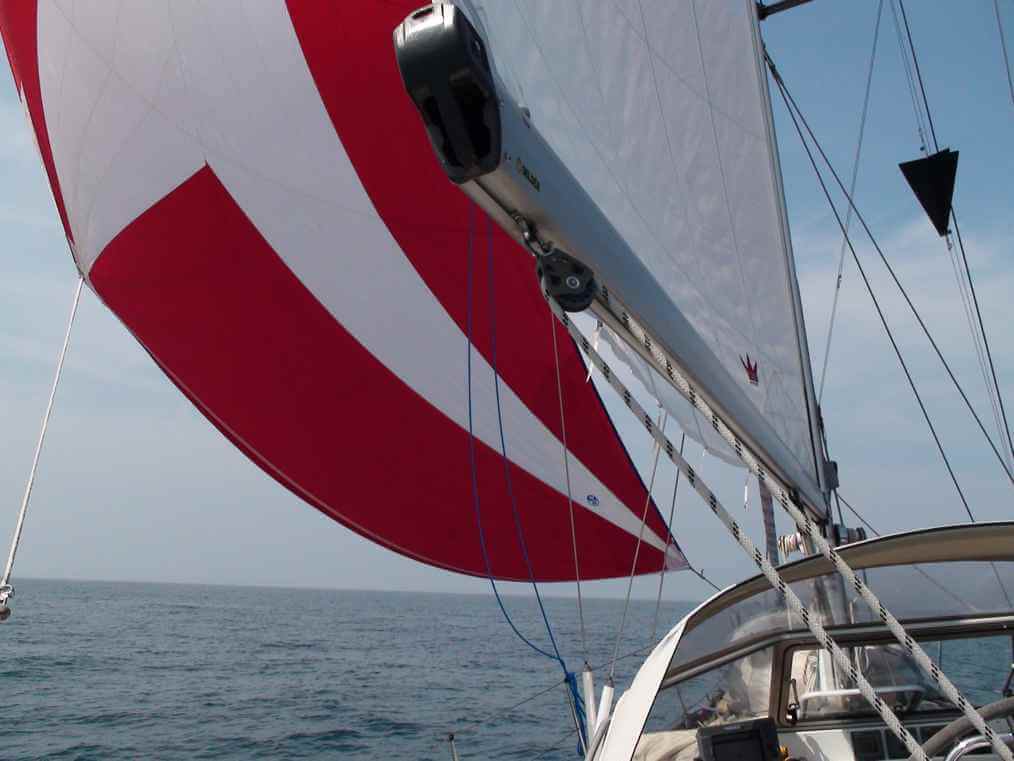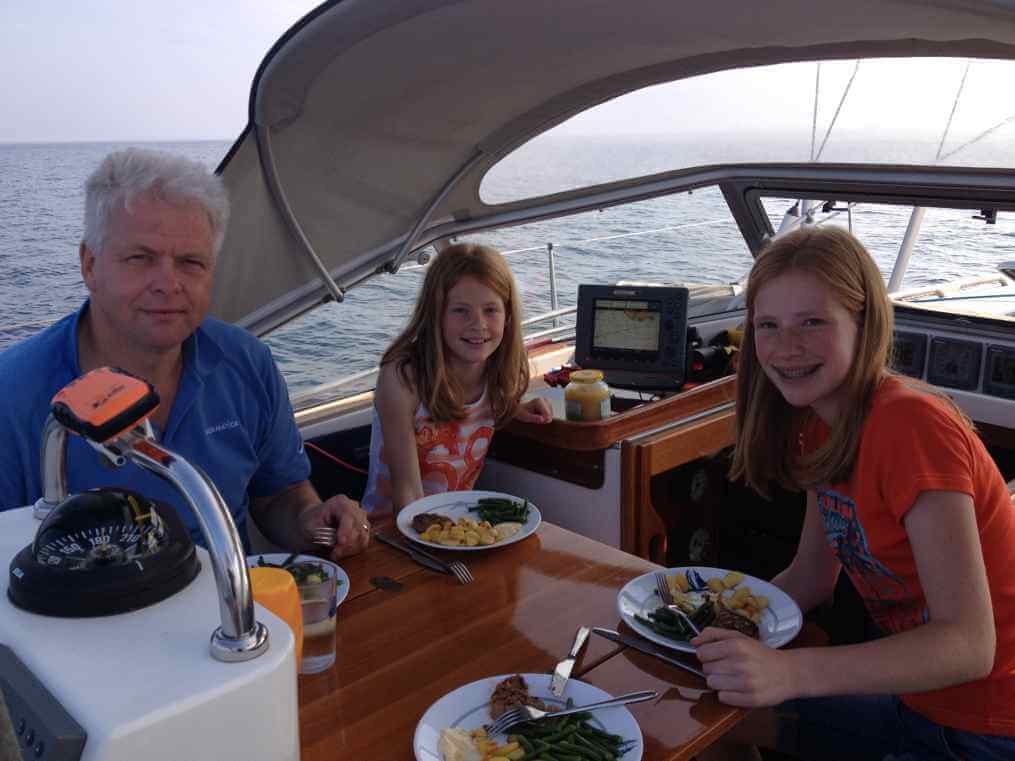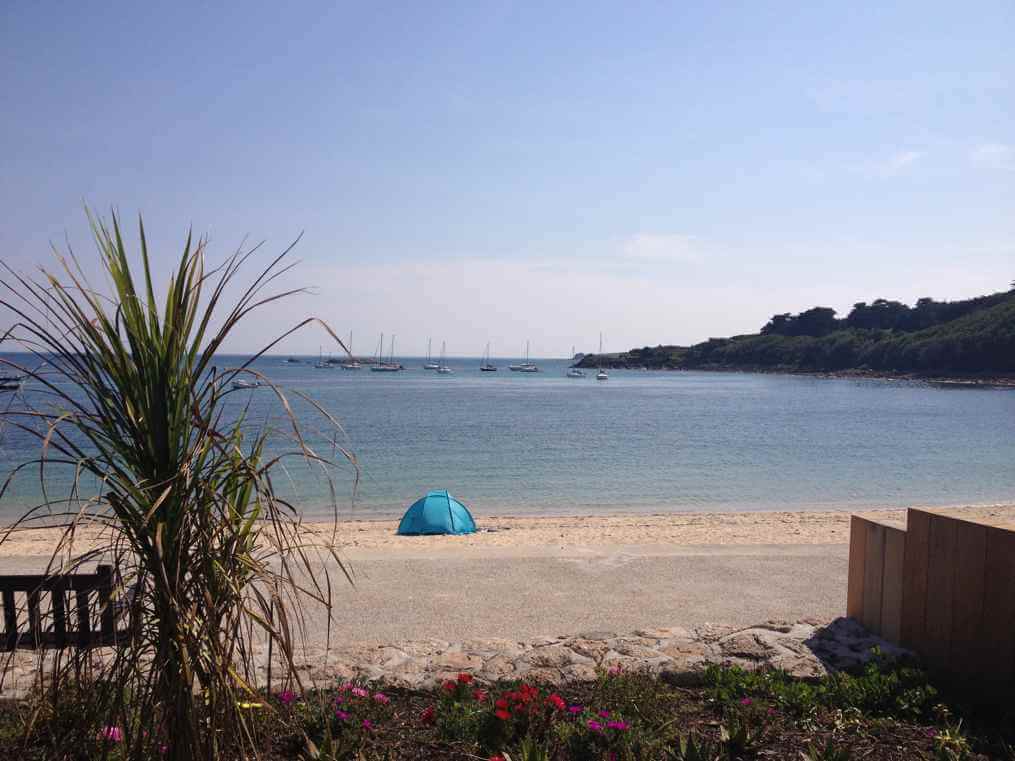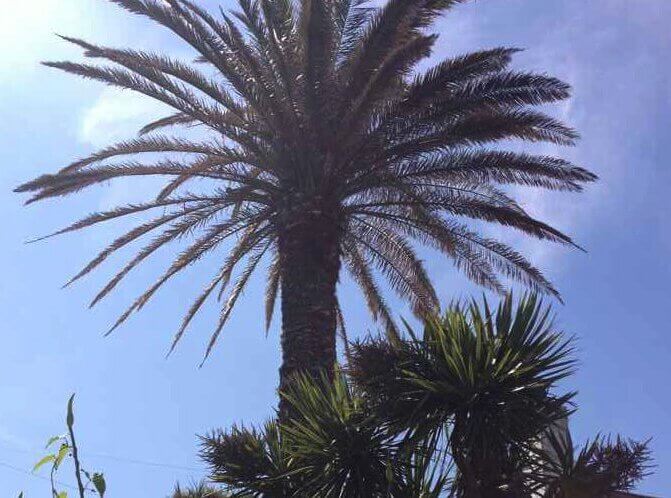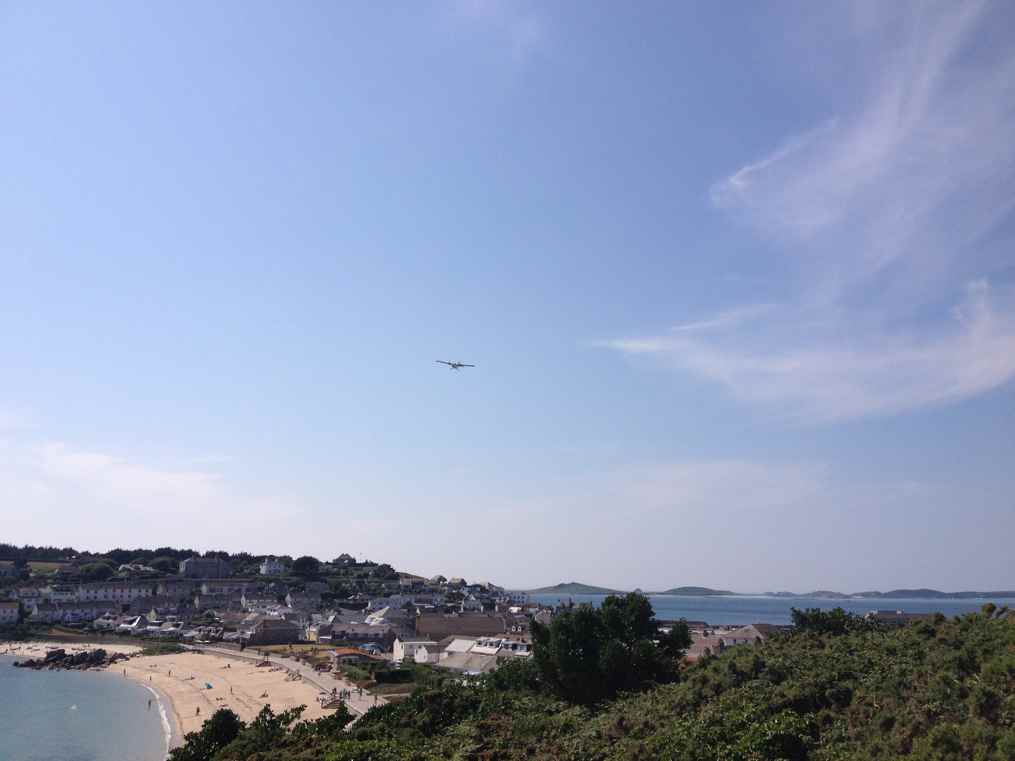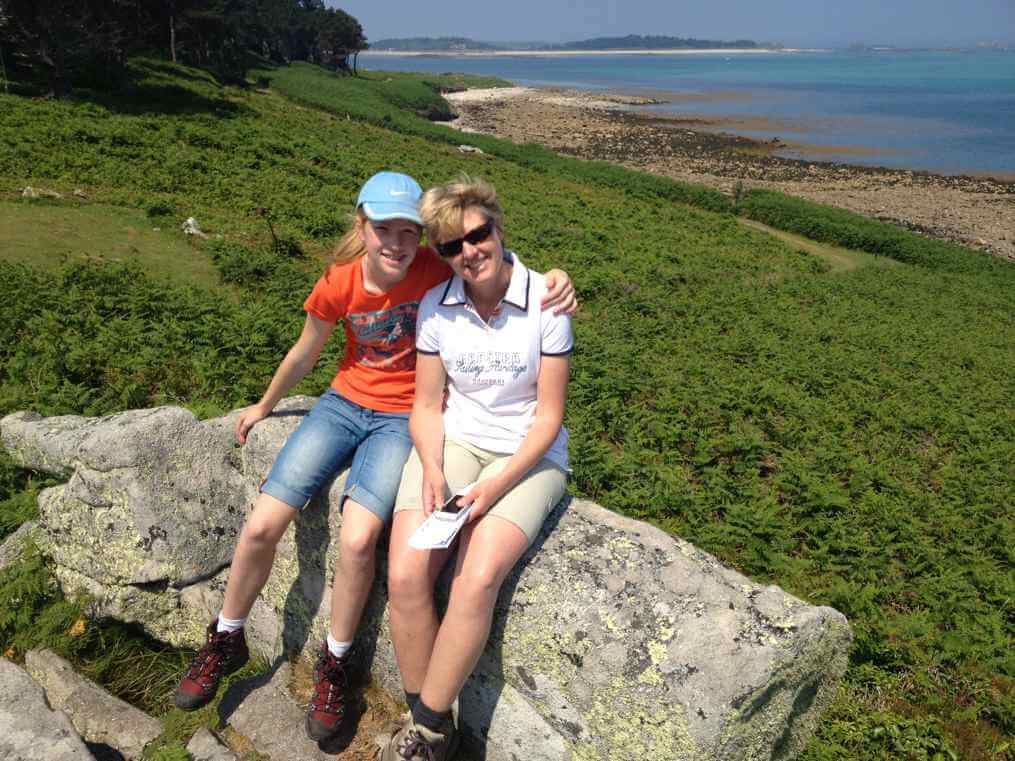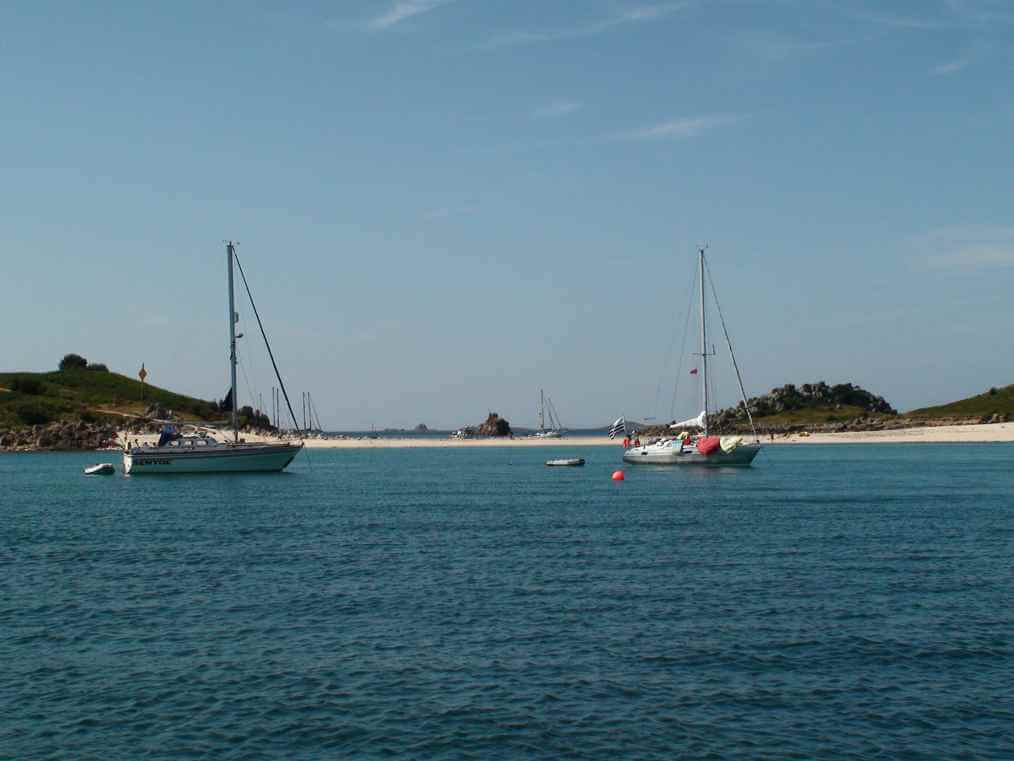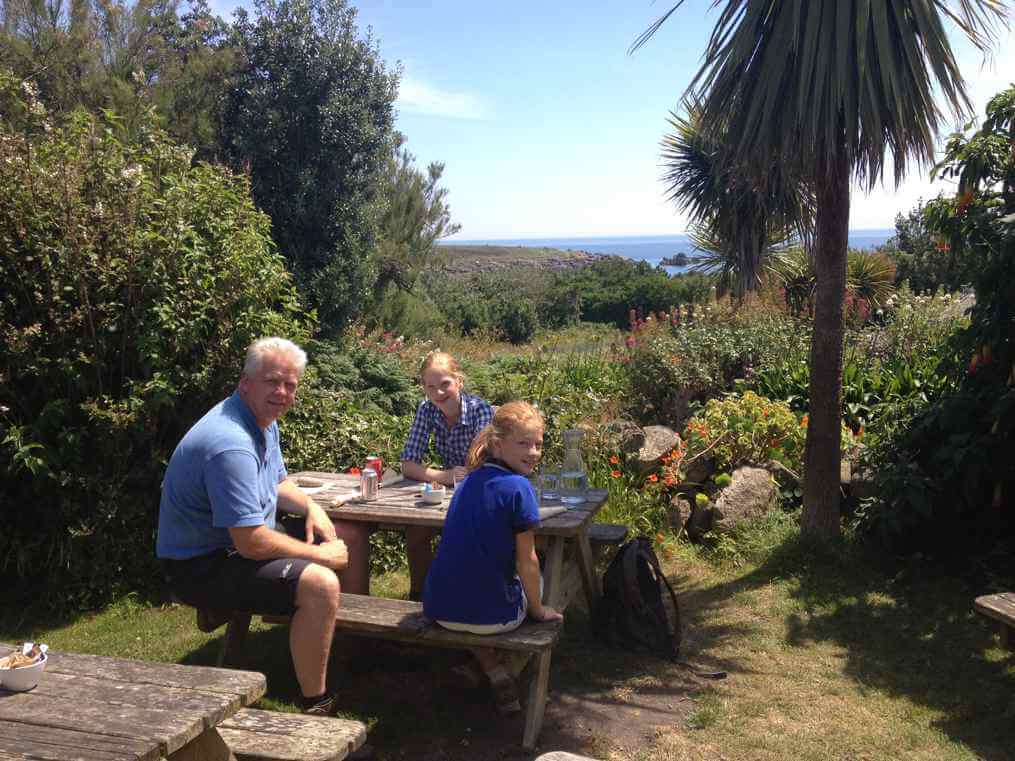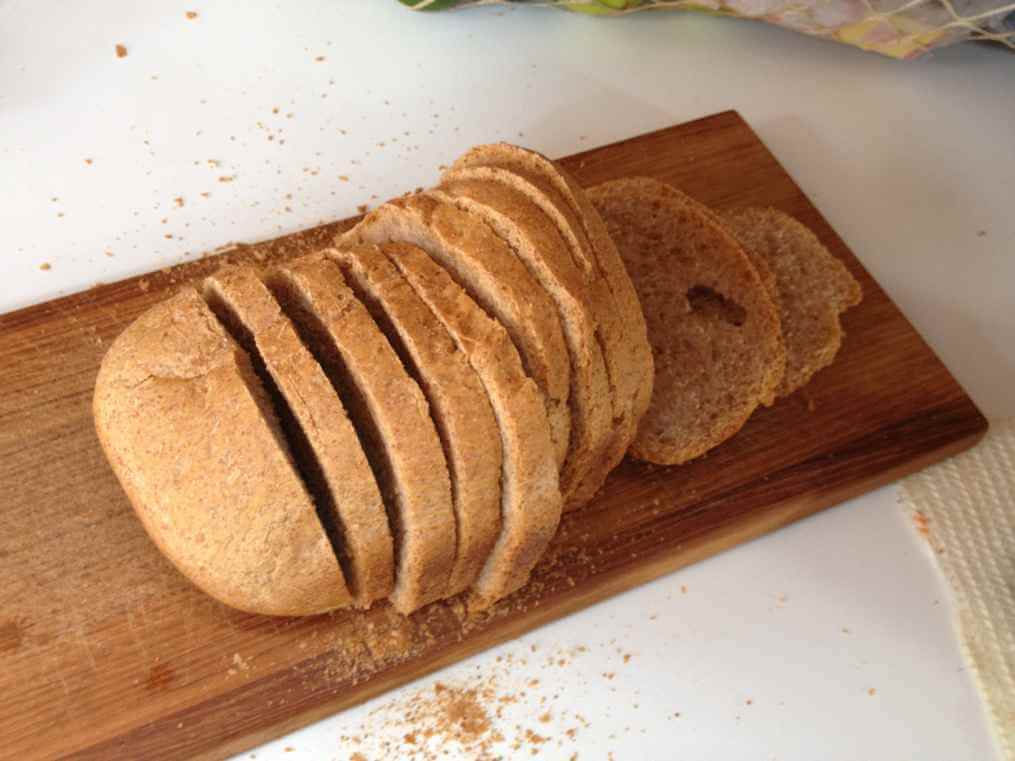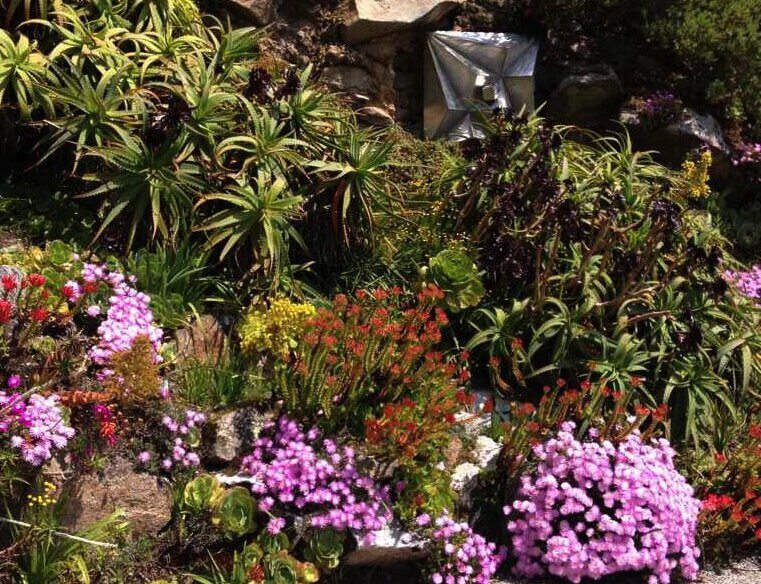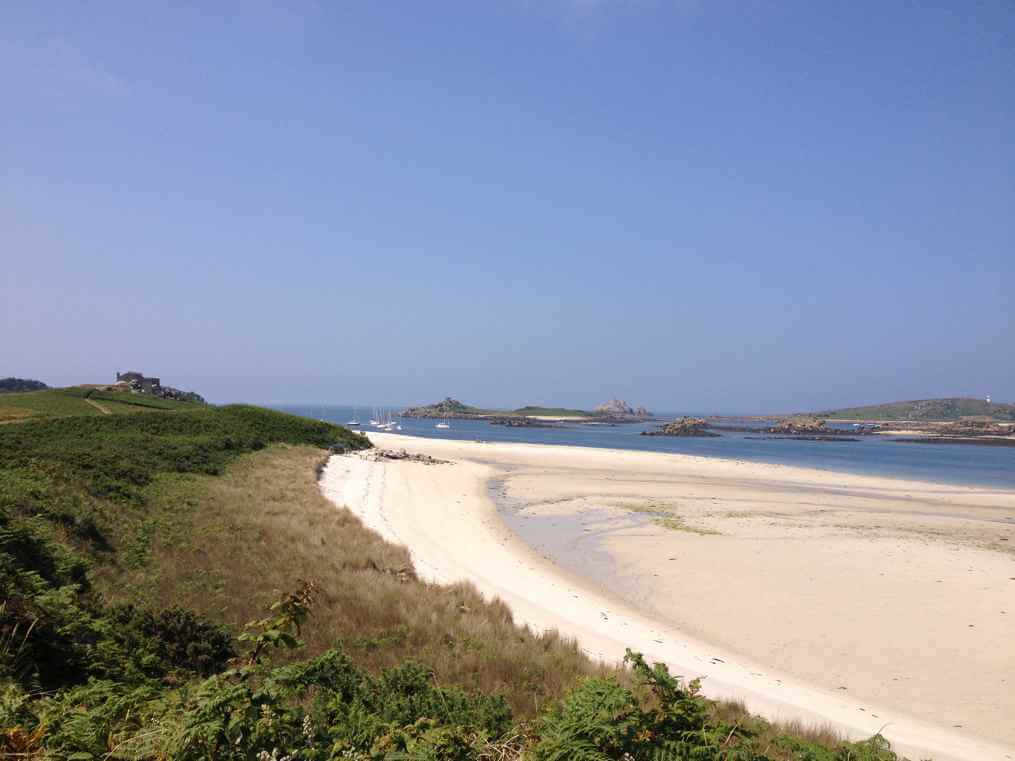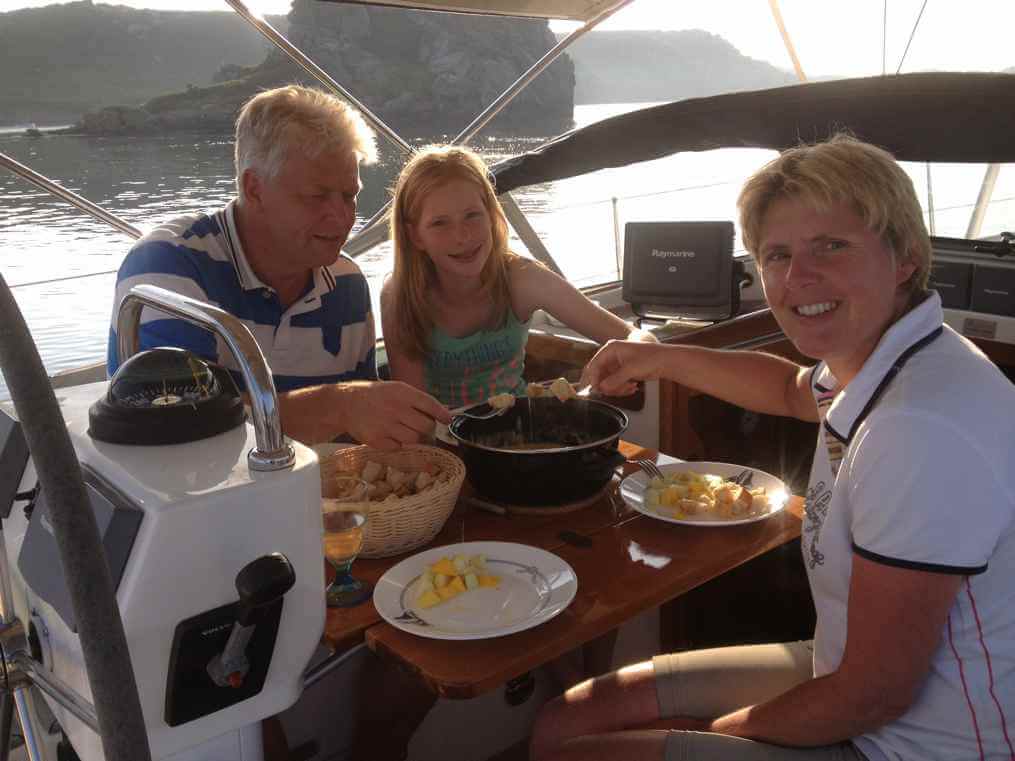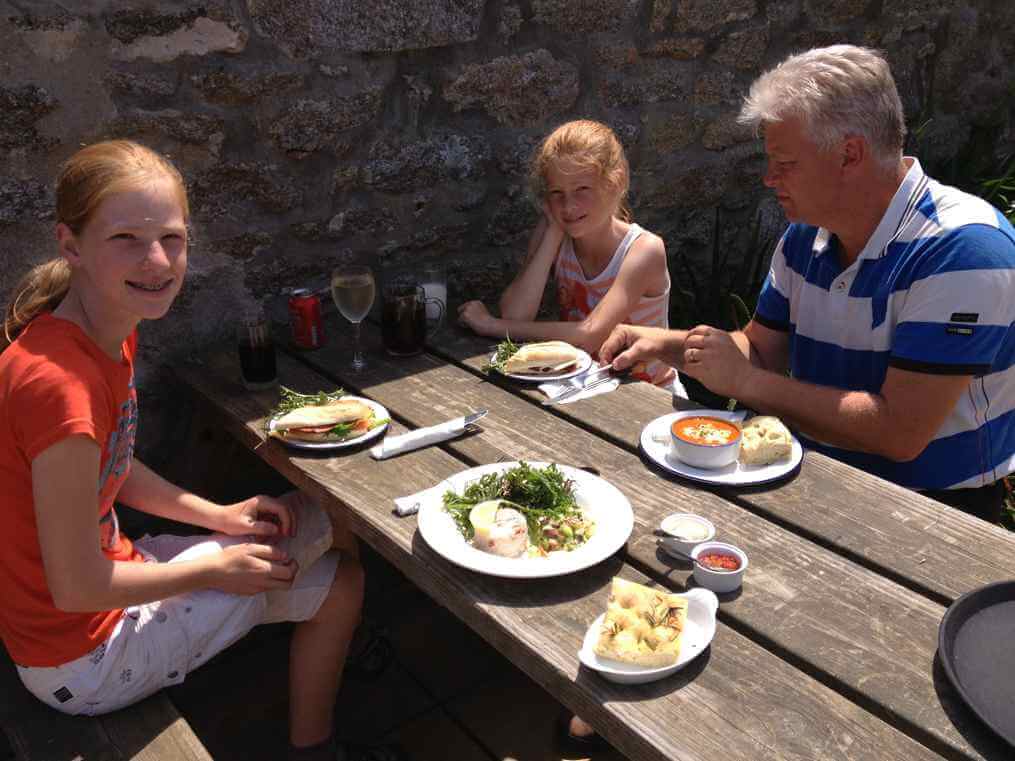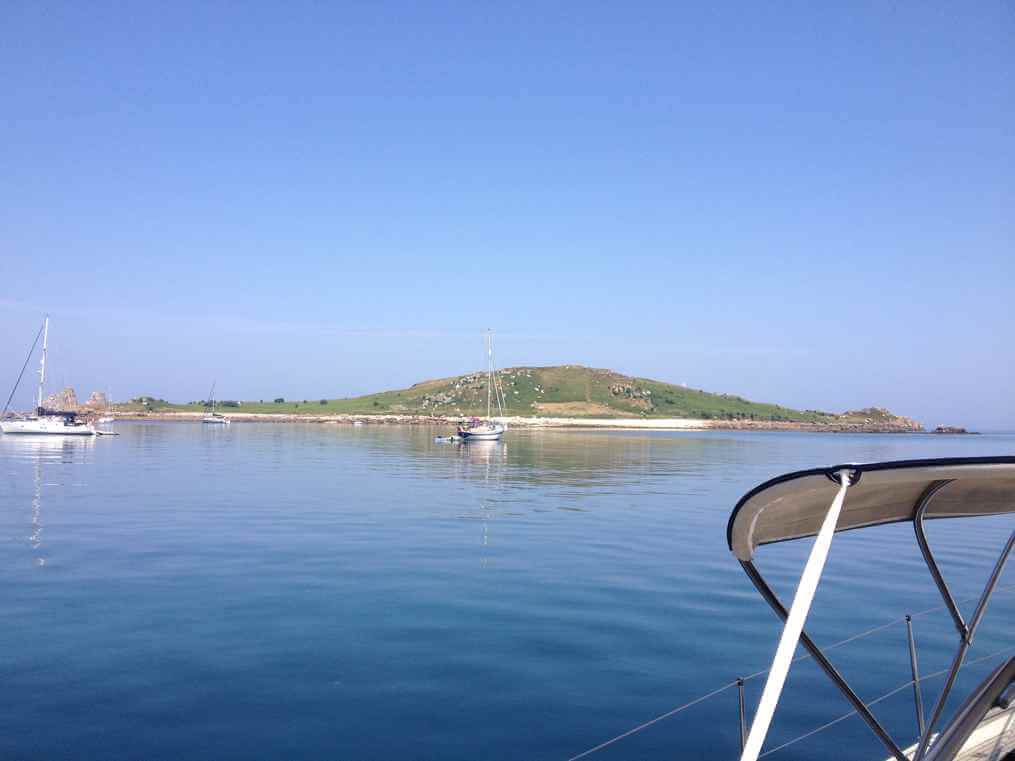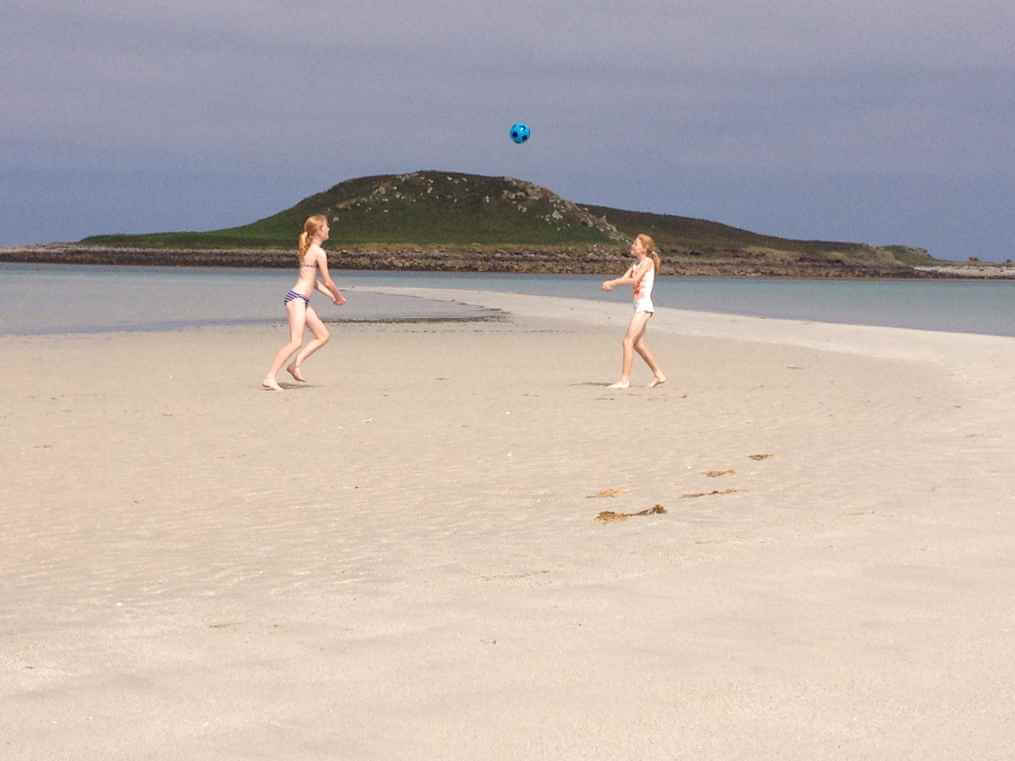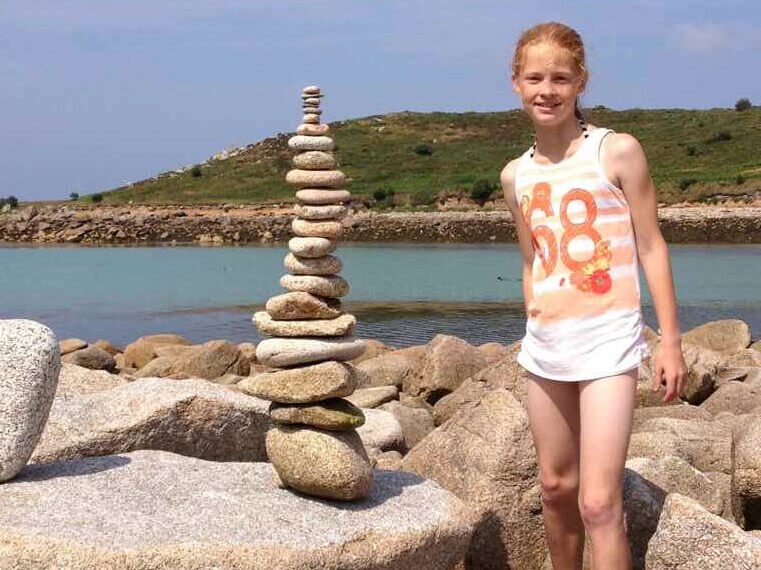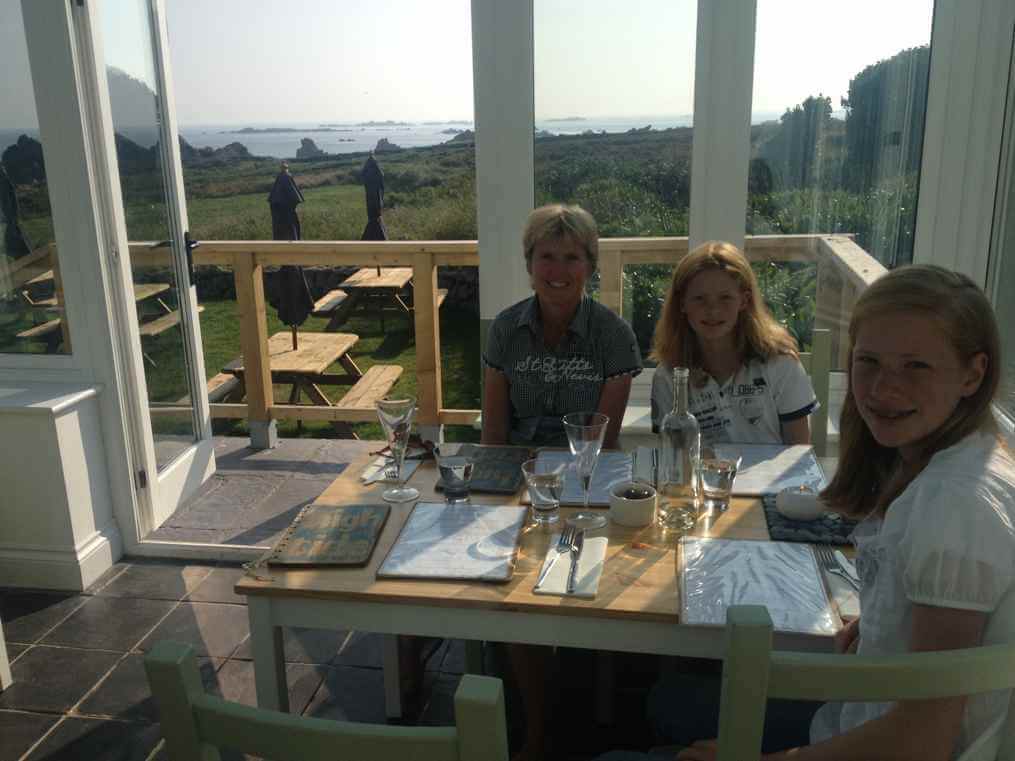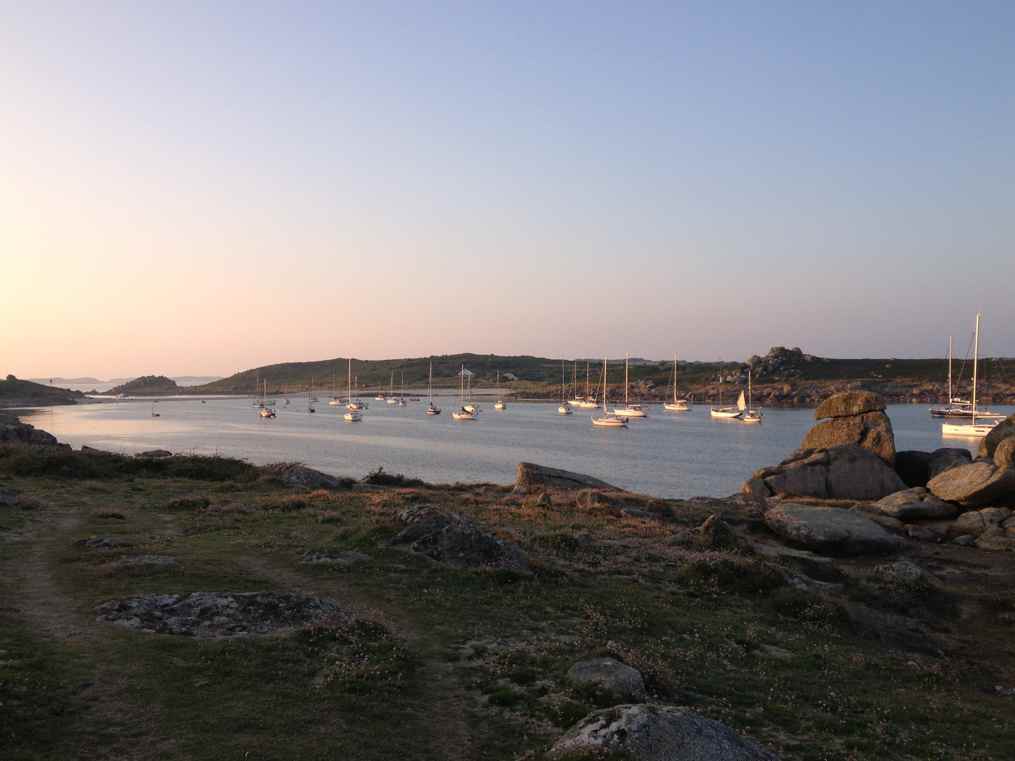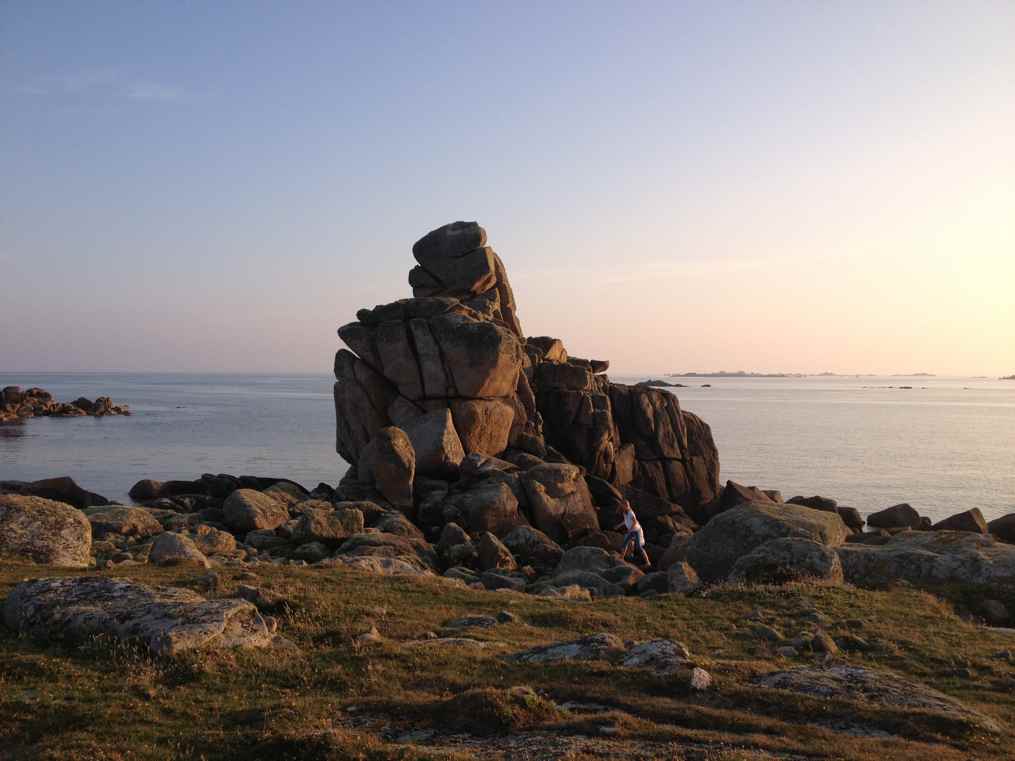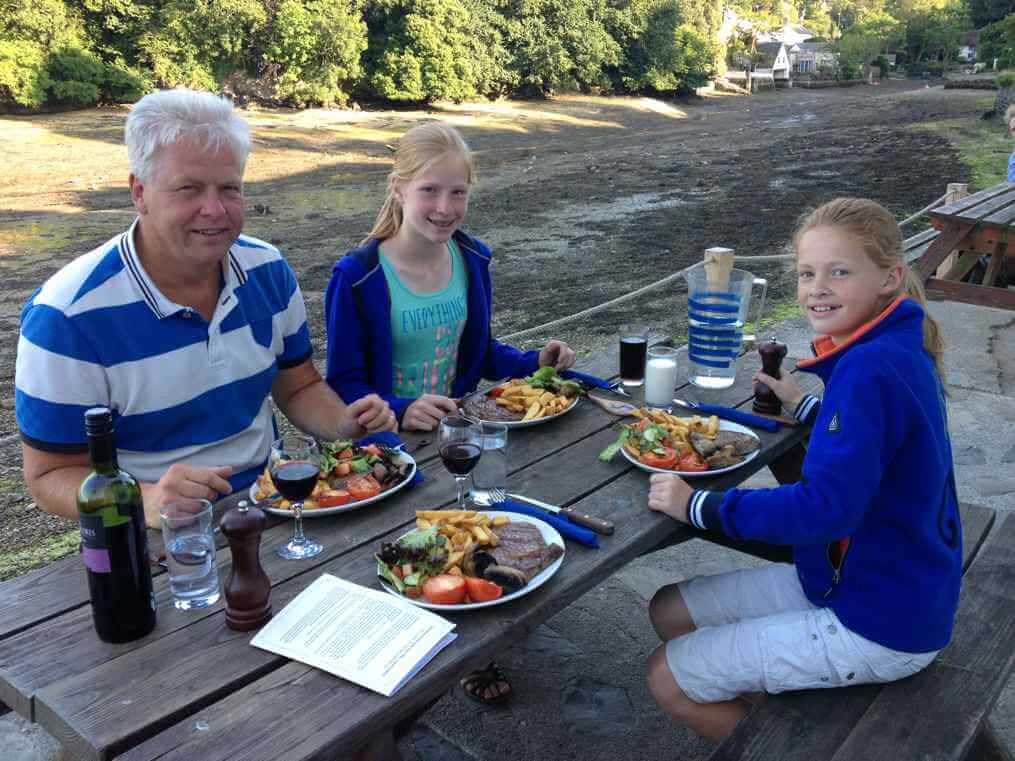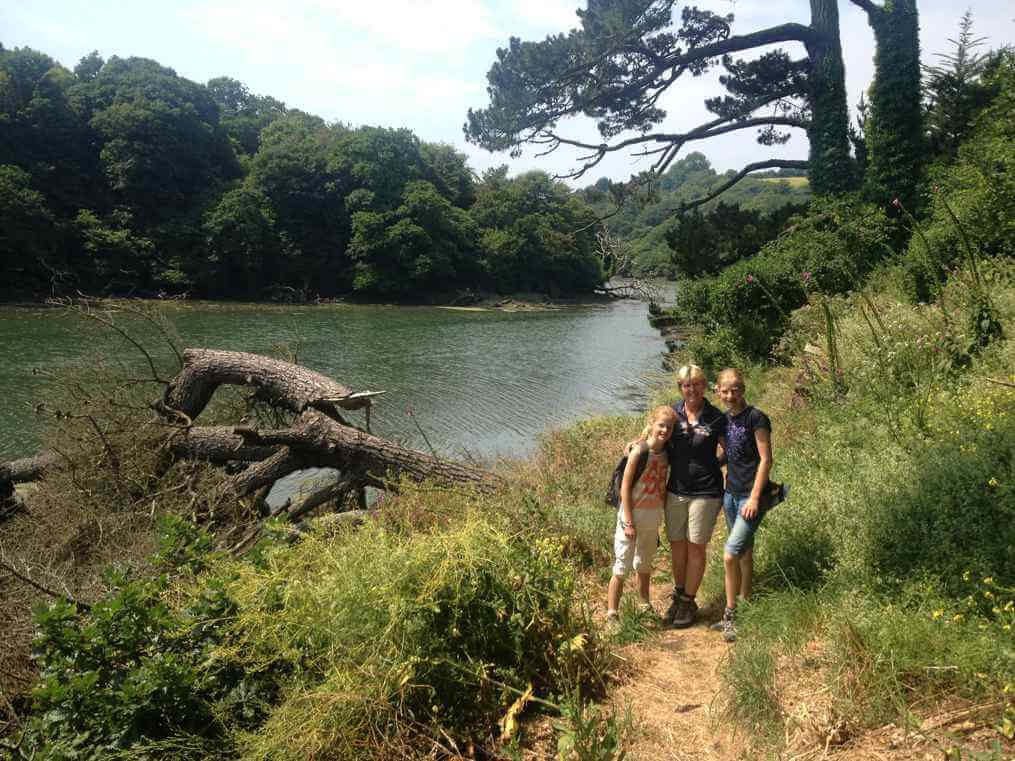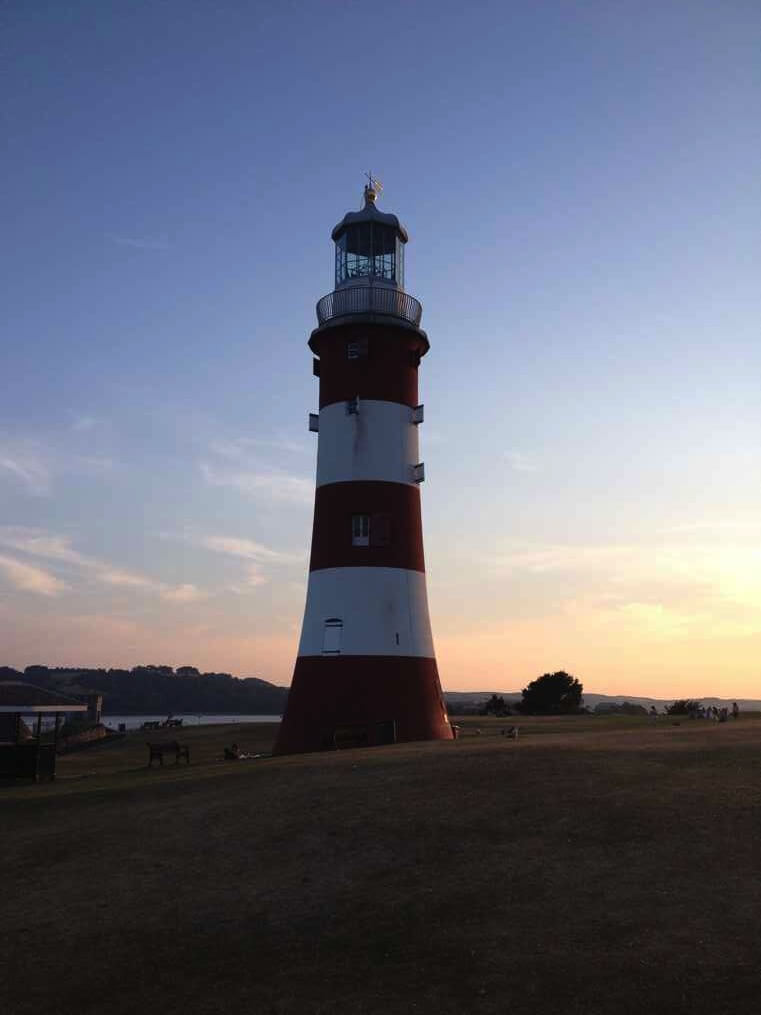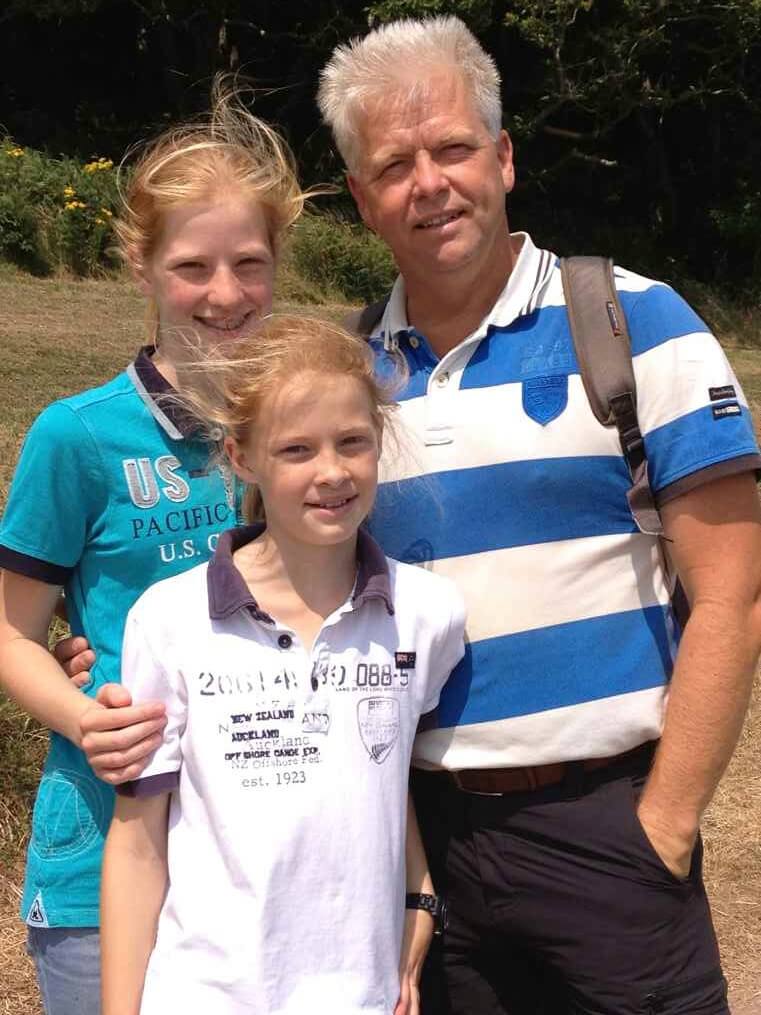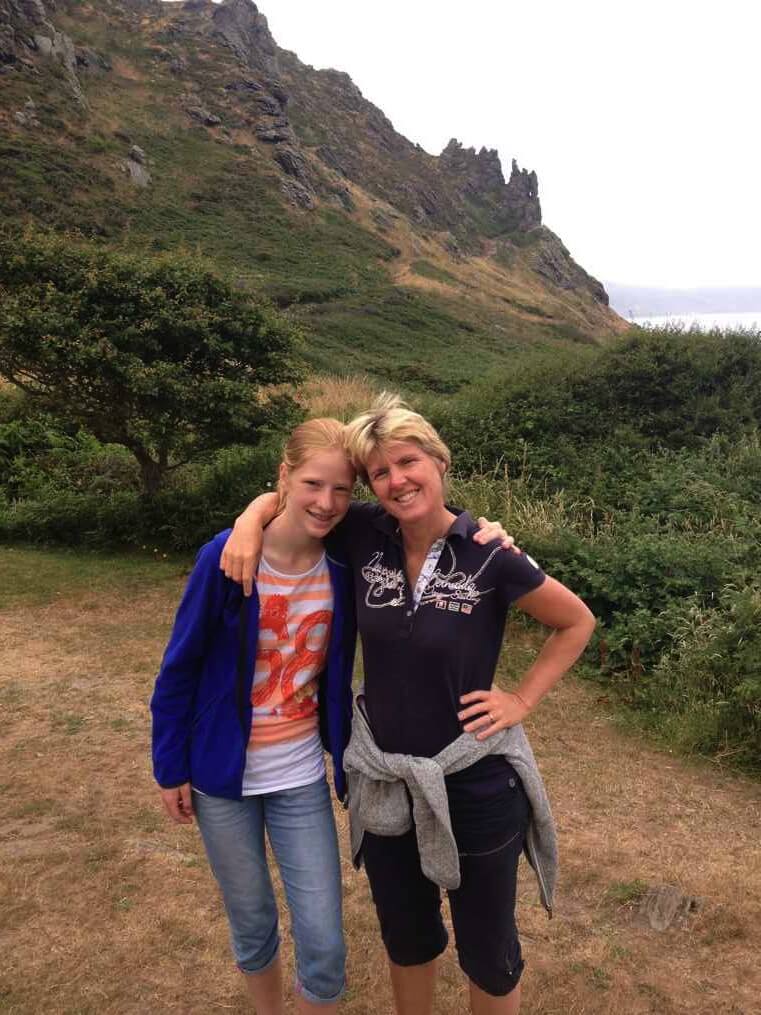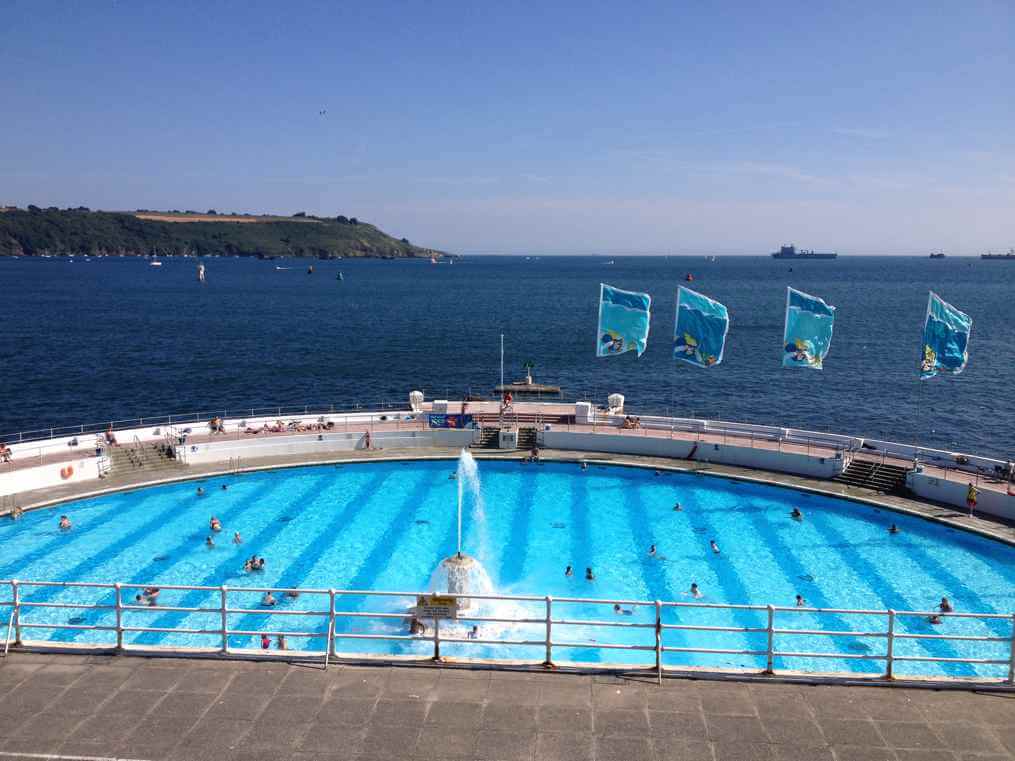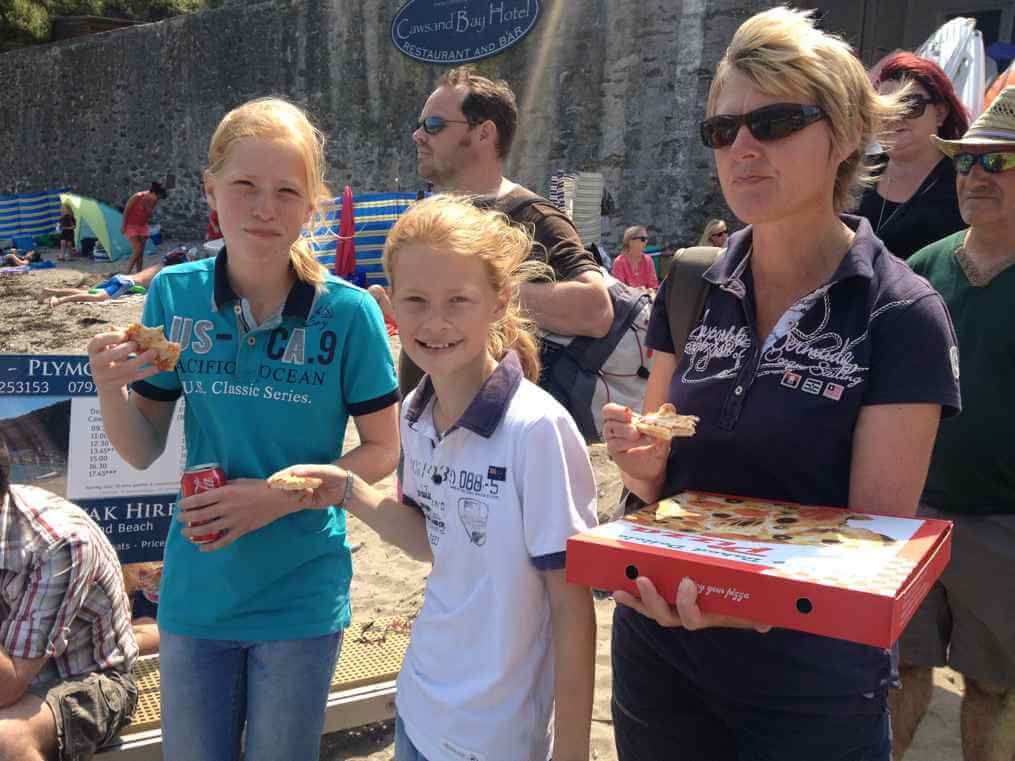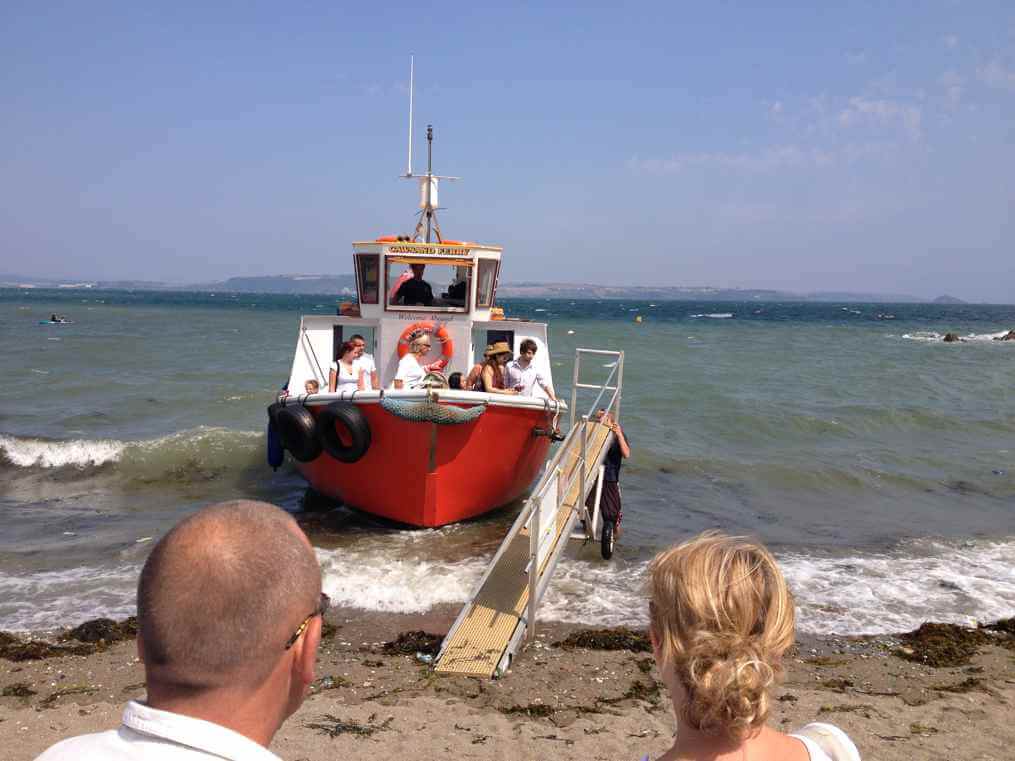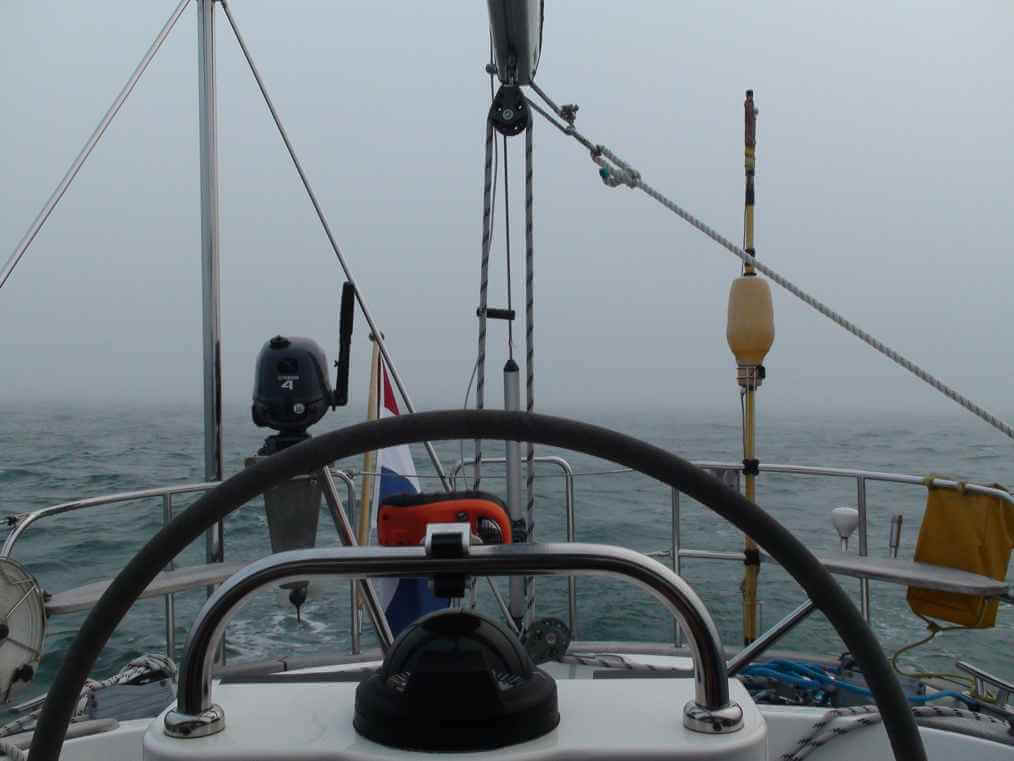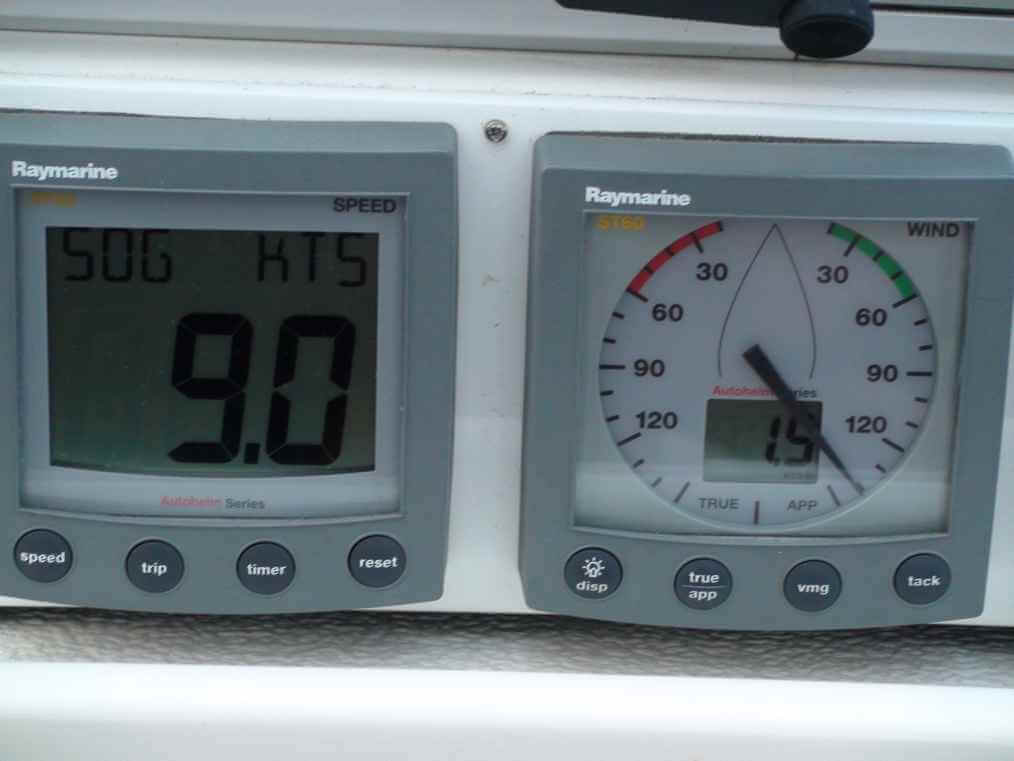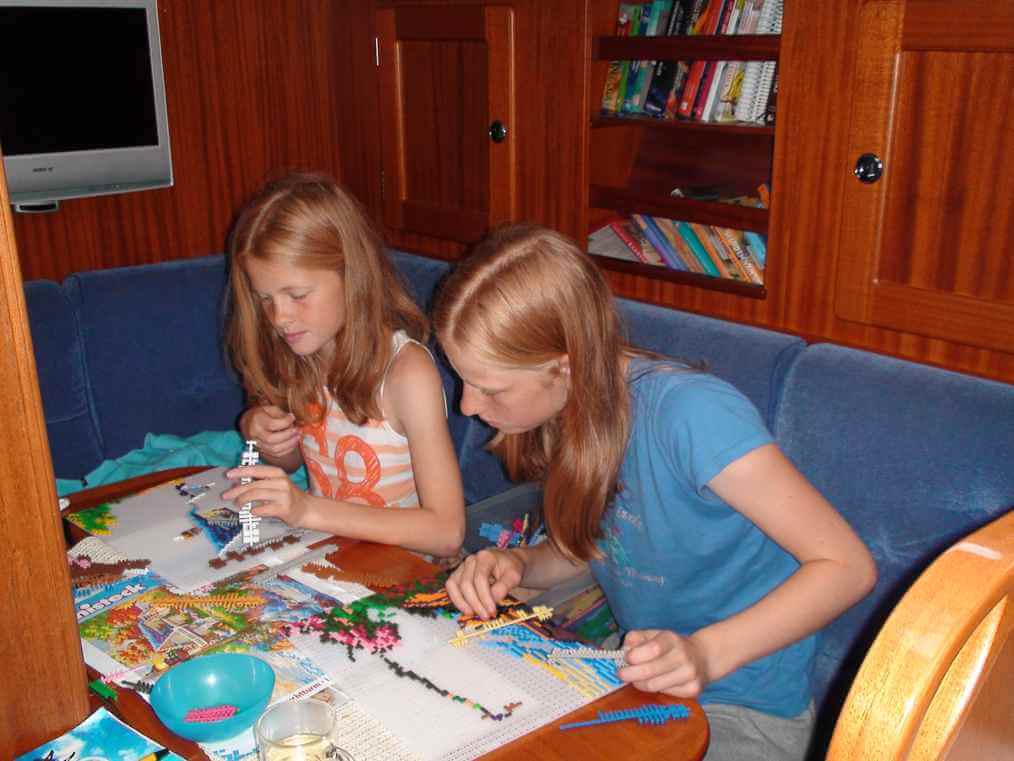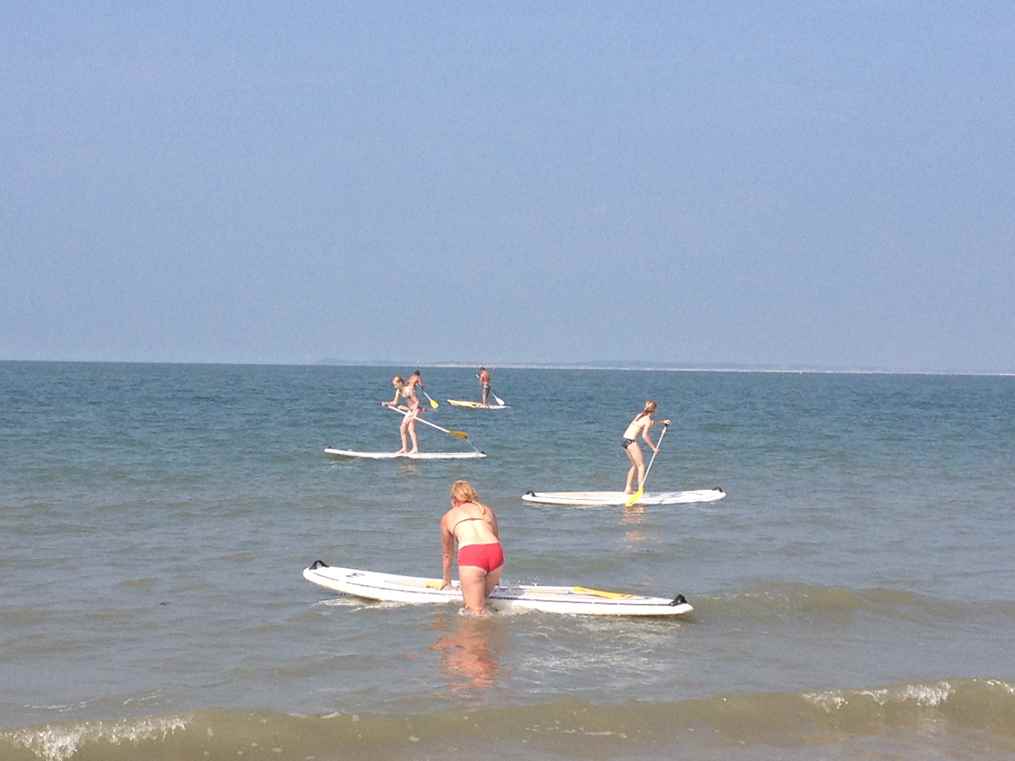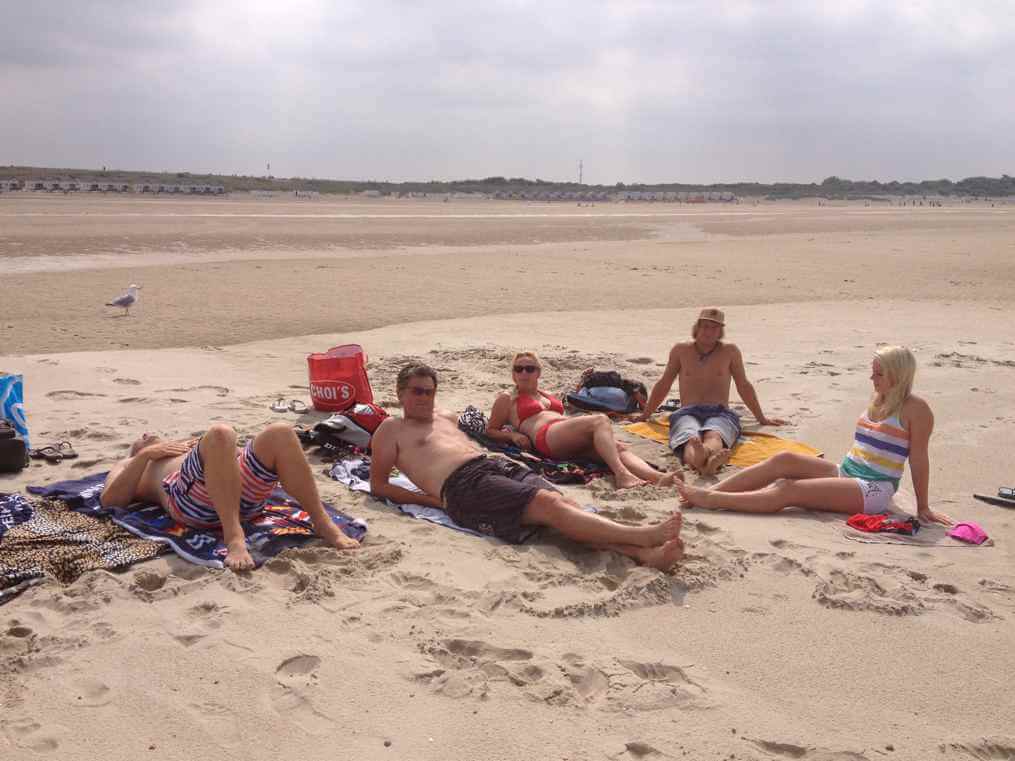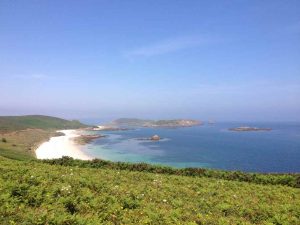 The first year with the Brandaan (in 2006) we had a beautiful summer with warm weather and a lot of east wind. We then made a round of canal with Wight, Cherbourg and the Channel Islands of Alderney, Guernsey and Sark as our furthest western destination. At that time we still thought that this was a fairly normal weather and those destinations were quite far away, weren't they? Now 7 years later we know better. It is quite exceptional that with good east wind (or very little wind) you can cover a considerable distance to the west in a short time. The golden rule is 'go as far west as possible as long as the wind permits'. You will always come back with the most prevailing south-west wind. The Isles of Scilly (a group of islands in the most south-western part of England, about 45 miles west of Cornwall) have been high on our wish list for years. Last year really can't be done because of the weather. This year we will? Yes!!!! A few days before our holiday starts it looks like there will be a stable high above England that will last at least a good week and provide stable and warm summer weather with little wind from the east. Exactly what we need!
The first year with the Brandaan (in 2006) we had a beautiful summer with warm weather and a lot of east wind. We then made a round of canal with Wight, Cherbourg and the Channel Islands of Alderney, Guernsey and Sark as our furthest western destination. At that time we still thought that this was a fairly normal weather and those destinations were quite far away, weren't they? Now 7 years later we know better. It is quite exceptional that with good east wind (or very little wind) you can cover a considerable distance to the west in a short time. The golden rule is 'go as far west as possible as long as the wind permits'. You will always come back with the most prevailing south-west wind. The Isles of Scilly (a group of islands in the most south-western part of England, about 45 miles west of Cornwall) have been high on our wish list for years. Last year really can't be done because of the weather. This year we will? Yes!!!! A few days before our holiday starts it looks like there will be a stable high above England that will last at least a good week and provide stable and warm summer weather with little wind from the east. Exactly what we need!
The first two days the wind is still from the south-west and we sail at a steady pace from Bruinisse via Veere to Vlissingen. Then we sail from Vlissingen out to sea and 75 hours later (just over three miles) we arrive on the Scilly Islands. The high pressure area remains stable over England for over a week. Therefore we have little wind and beautiful sun and warm weather. Exactly what is needed to enjoy the Scilly Islands to the fullest. We spend 9 days in 6 different and all beautiful anchor bays. Regularly we make a nice walk over the islands which have a rough and rich subtropical vegetation. We stopped counting the number of palm trees. Every day we go to the beach and even swim in the sea. The bimini (sun tent) stands up. All this makes for a for Europe exceptional Caribbean feeling!
Then suddenly the wind doesn't come from the east but from the north-west and it's time to go back a bit. We sail back to Plymouth Bay in a long daytrip and spend a week on/in the Helford River, Plymouth and Salcombe. We actually wanted to spend some time in the next bay (Lyme bay) but there is a very strong east wind for three days and it 'holds' us in Plymouth. After the last stop in Salcombe the wind turns nice to the south-west and it is time to go home. We sail back to Vlissingen in 50 hours with an optimal flow planning (at all capes we have current with us). The last two days we spend together with the Barbarossa on the Veerse Meer at anchor near Vrouwenpolder. A nice way to end a perfect holiday. We had exactly the right 'weather window' with good summer weather and no rain. Only the last day back to Bru thunderstorms and rains and we renewed our site just before the holiday. Because of this we can regularly send a twitter message with the latest news and the spot also shows our last position on the site via twitter. Read a report from day to day below.
On Tuesday evening 2 July we leave for Bruinisse. Toine has had his steering group and after that we can leave. It is still very quiet in Bru. We traditionally eat mussels at Sailors Inn as the start of our holiday. The next day we sail at our leisure (against the wind) to Veere. We have no waiting time at the locks and encounter few other boats. Also in Veere it is still very quiet and that remains a beautiful Zeeland picturesque town with a huge church. The next day we sail through the Walcheren canal with two locks and five bridges. This always takes quite some time, especially since we're just in the middle of two newly set blue zones. In Vlissingen it's also nice to be in the middle of the city harbour. We forgot our swimsuits and we can stop by the Hema to buy them. There is a street festival (de Onderstroom) with all kinds of performances. Well, we like to stroll along the quay of Vlissingen with a view on the Westerschelde and the big seagoing ships that sail there.
Friday the 5th of July at half past 11 we leave the sea along the Belgian coast to the west-southwest before we cross the shippinglane from Calais to Dover. It is a calm sea with little wind. Engines with the sails and so we make an average speed of just over 5 knots. A bit less with current against and a bit more with current. The day passes quietly. All four of us take our 'crossing' rhythm very easily and we get through the days at sea very well. In the middle of the dark night without a moon we cross the busy shippinglane. Without any problems and just a short swerve to cross behind a large cargo ship. When I take over the watch at 6 o'clock in the morning we are already past Dover and sail along the first southern English cape Dungeness on our way to the next cape Beachy Head. Enjoying the sun on a flat sea. Dinner distance 125 nm.
Beachy Head is a cape with 160 meter high chalk cliffs and a beautiful red and white striped lighthouse. With this beautiful weather we can get very close. The rest of the day we sail quietly in the direction of Wight. Toine gets the water maker working, which is very nice. Because that way we are quite independent of marinas and we always have enough water. We can eat from plates on the table, that's how flat the sea is. Every evening we play Canasta. Just before Wight and before the night watch we see two whales, we almost know for sure. In the middle of the night we pass Wight underneath. At night we notice that the boat vibrates a bit more (from the engine) than usual. Also the cooker resonates and it never does that otherwise. Dinner distance 125 nm. Another 150 nm to go.
When everyone is awake again we suddenly hear a beeping sound ... which turns out ... the V-belts are almost through and that's because the block on which the dynamo hangs is partly broken off, causing the dynamo to hang skewed and the V-belts to heavy. Jeez, that's a bit of a scare. The engine turns off immediately and only on the genaker we make enough progress. Toine dives into the engine room and after a lot of hard work he manages to secure the alternator well enough again. Fortunately, otherwise we would have had to divert to Dartmourth, the closest harbour with facilities (20 miles away). So that's why there's more vibration than usual and that's gone now. We continue sailing for a while but then the wind drops again and the engine starts again. We can just see the last part of the Wimbledon final between Murray and Djokovic on the TV receiver. Then we are just close enough to land to receive the BBC. And so we enter the third and last night at sea, on a mirror smooth sea with little wind. In the morning the wind picks up a bit and the last stretch to the Scillie islands we can sail in clover mode, a favourite position of the Brandaan. We sail past the famous Wulf Rock lighthouse and cross the shippinglane (direction Ireland and Scotland). We were here three years ago when we made a detour home via Scotland from Falmouth. Just before we reach the Scillie Islands we are treated to a dolphin show of two very playful and fast dolphins. Welcome to the Isles of Scilly!!!!
On Monday afternoon half past two we pick up a mooring in Pont Cressa, the southern bay of St Mary's's main island. A beautiful bay with beautiful clear light blue water and a white sandy beach. Further around us rough rock formations. This gives us very much the Caribbean feeling! Even the bimini stands up and is much needed to get some shade in the warm sun. Only the water is much colder, but that is the only difference.
We rig up the dinghy; it's still at the bottom of our bed and has to be pumped up first. And then with the dinghy to the beach. The four of us raise the beach quite high because the decay here is 5 meters. We walk around in the village, with the only supermarket of all the islands, and a lot of shops and restaurants. We make a short walk to the lighthouse on the southern tip and after that we have a nice dinner in a small restaurant on the bay with a lot of wine! With a lot of fun (the girls act like they've been drinking too) we walk back to the dinghy and arrive safely and already back on the Brandaan. We have a good night despite the hour of rolling in the middle of the night because of the swell entering the bay.
On Tuesday the 9th of July we make a long walk (of about four hours) around the whole island. Very nice and tiring. There is a beautiful subtropical planting. There are many palm trees and many other subtropical plant species with beautiful coloured flowers. On the tops of the islands it is rougher with rocks, heather and ferns. In between we picnic with baguette, salami and cheese. We walk along the coast and get a good picture of the whole island kingdom. In between we take our time so Marinthe can clamber on the rocks. At the end of the afternoon back in our bay we lie on the beach and the girls even go for a swim. Especially Eline is the big swimming hero in this cold water. In the evening we eat skewers on the BBQ on the boat. A lovely day like this!
The next day we leave for the next island after breakfast. St Agnes on the south side. We drop anchor at a good spot in the southern bay The Cove. The Cove is connected to the northern bay by a small beach that is just below the surface at high tide, making it two islands. A really nice anchorage. We don't have that much excitement to go for a long walk and take a short look at the island and then have a delicious lunch in the garden at a small cafe. In the afternoon we relax on the boat and at the end of the afternoon we go to the beach. There we see the 'bar' between the two islands quickly flooded. And we even go for a swim together! We eat pasta on the boat and after a game of Canasta we go to bed on time.
We regularly have breakfast with our own baked sandwich. I am often awake at 6 or 7 in the morning and turn on the bread machine. Two hours later the sandwich is ready. Lovely to have breakfast with all four of us. Besides that, getting bread on the side every morning is not an option. Then it is time for the next island. We make the round of islands clockwise. It is one hour of sailing and then we are already there. We drop anchor between the islands of Tresco and Bryher. It is a bit busier here with boats, so this is the most sheltered anchorage. In the afternoon we take a walk on Bryher, the smaller of the two islands. With a rugged coast on the north-west side. A lot of ships have walked and perished on the rocks here. Especially in the old days when they had no navigation equipment. The girls climb the rocks a lot while we watch them on a spot in the grass. In the evening we eat on the boat and play Canasta.
We stay another day and visit Tresco, the bigger island. There is a beautiful botanical garden that was created in 1834 and has been extended for years by a family including sailor Augustus Smith with many plant species from all over the world. The climate in the Scilly Islands is ideal for plant species that do well between 30 and 45 degrees. There is relatively a lot of rain, high humidity, warm winters (never below 4 degrees) and plenty of sunshine. All this because the warm Gulf Stream from the Caribbean flows along the islands. It really is a beautiful garden with many trees and plants from Mediterranean areas, Chile, Japan, Australia, etc. The girls make all the pictures. There is also a small museum with figureheads of ships stranded on the Scilly Islands. That is quite a collection. On the way back we make a walk along the east side of the island. There we have a view on a couple of beautiful anchor bays where we will go the next days. Once back on the boat we quickly grab the swimming and beach gear and go to our private beach close to the boat. The girls got a ball and go volleyball in the water. And we all swim again! In the evening we eat cheese fondue on the boat.
The nice weather just keeps on going. There is a stable high pressure area over England. Ideal to explore the Isles of Scilly extensively. Sometimes it feels a bit 'too' easy for us. Shouldn't we also go to Ireland or even further to the Hebrides? For a moment we both feel that unease, but we don't do it. That would also be mainly on the motorcycle and it is lovely here, isn't it? We move up another bay to St Helens Pool. We can only get there at high tide, between all the rocks. Long live our navigation system! Only that morning it took much longer before it found enough satellites for the GPS fix.The whole afternoon we go to the beach; a very long white sandy beach with shallow light blue water for swimming. In the evening we eat again on the boat and we play Canasta; each time in a different composition. At night, there is thick fog and we hear the St Helen's lighthouse make four short beeps each time.
After the fog has cleared we move up another bay to Tean Sound near the island of St Martin. We are almost alone there. This is the fifth and last inhabited island we visit. But there is not much habitation here. The big hotel has gone bankrupt at the beginning of this year and is closed. Yet there is a school. We take a short walk on the island and have a delicious lunch in a cafe in Higher Town. On the way back the fog comes back. This is sea fog that occurs when the water temperature is about 15 degrees and on land between 25 and 30. Then we have some time to do some chores on the boat. Toine repairs the reading lights and I clean up a bit. Luckily at the end of the afternoon it is gone again and we can go to the beach for a while. Long live the water maker! That way we always have enough water to take a short shower after swimming. For water we should go to St Mary's main island. And then, after a shower, enjoy a glass of wine lying at anchor in beautiful surroundings. Surely those are the better moments!
As our last new anchorage we go to Great Ganilly, an uninhabited island part of the Eastern Islands. Again a very nice anchor bay just in front of a white sandbank that is above water at low tide and flows under again at high tide. Toine makes it a cleaning day; with the dinghy he polishes the whole white sides of the boat. Quite a heavy job. I read a lot and go with the girls to our own white beach at low tide. Then all of a sudden we get a visit from the Waltzing Mathilda; a Dutch departure boat on the way back with Mathieu and Roos and their children Fien and Max of 9 and 7 years old. We invite them for a drink and it's so nice that they also stay for dinner with our joint eating stuff at the BBQ. Lovely to dream away for a while in the departure world, to hear their stories and reminisce about themselves. As I recently read on the site of the Thalasa II ...once a 'departer', you always stay 'departer', even on shorter sailing trips. That feeling is in us and will never go away.
The last day in the Isles of Scilly we spend at St Agnes in anchor bay The Cove. We lay there the third night. A very nice bay with a nice beach and a nice restaurant on the island. Before we sail there we take the dinghy to a place near some shallow rocks with lots of seals. They curiously swim around our boat. If we had good wetsuits, we would have been able to swim with them. But without them the water is really too cold. Well, from the dinghy it is also a beautiful sight. In the afternoon we go to the beach again and after that we go in the direction nicely dressed. Always with the same ritual ... barefoot in the dinghy, landing on the beach, lifting the boat with the four of us and carrying it to a place where the water won't come, then sanding feet and putting on (walking) shoes. We have dinner in a very nice little restaurant with delicious food and a view of the Bishops Rock lighthouse. After dinner we walk with a detour over the island in the setting sun back to the boat. A great last evening on the Scilly Islands!
On Wednesday the 17th of July at 5.30 am we sail out of the bay back to the 'mainland'. More than 10 hours of sailing (55 miles) with a calm breeze in the back of which we can sail half without an engine, even crossing the last part around the corner at Lizard Point in the direction of the Helford River. That is a very beautiful river just below Falmouth. Beautiful wooded nature with the small idilic village of Helford with white houses and thatched roofs. We are moored and eat delicious steak with chips in a pub on the waterfront.
The next day we take a nice walk of about 4 hours along the banks of the Helford River, and two other creeks. It is still lovely hot summer weather and fortunately much of the walk is in the shade under the trees. We have lunch at a small traditional pub in the middle of nowhere. Tired come we get back to the boat and then, of course, it's time for another drink of chips. Around us there is enough to see with boats and rowers in and out ... a nice activity.
We woke up early again (without an alarm clock) and left around 5.15 am for the 50 mile trip to Salcombe. We knew it would be against the wind, but we thought it was very little wind. But half the wind starts blowing harder and harder and then it's no fun anymore to use the engine against the waves and that for another four hours or so. Why don't we go to Plymouth first? That's another 1.5 hours of wonderful half wind sailing. Then a day later we go to Salcombe. Plymouth turns out to be a nice city. So no wrong choice. Suddenly we are in a marina while we were 'planning' to just anchor this holiday. Well, it has its advantages because we also have WIFI since a long time. And in the evening we have dinner at a Japanese restaurant.
The strong easterly wind keeps blowing, but maybe we can go high up under the coast to Salcombe? At least that's what we're going to try. Once outside it appears to be blowing quite a bit ... wind force 7-8 with a considerable seaway and we don't save the course by sailing maximum high. Well, going back isn't really our thing either, but we'll do it anyway. After all it is a holiday and despite the strong wind it is nice and warm and sunny. A bit later we are back in the marina, this time in the harbour in the middle of the old part of town. Toine is going to do some jobs on the dinghy engine (it still doesn't run well and with a downloaded manual you might find the problem). I go 'shopping' with the girls in a big shopping mall. And when we come back hot it's time to go to the saltwater pool. That's very nice on the coast overlooking Plymouth Bay. Toine found the problem with the trailer engine (caborateur cleaned) and so we still have a great day!
The next day the wind is still too strong to continue. We are going to make an 'adventurous' walk on the Cornwall side of Plymouth. There is a little bit in the bus and a small 'foot ferry'. It takes a while before we have found the bus, but just in time because it appears to drive only once an hour and it arrives a few minutes after we get to the stop. It is only a short drive. The 'foot ferry' is also only short, but overcrowded with people from Plymouth who are going to spend their Sunday on the beautiful peninsula in Cornwall. It is a nice walk along the coast through woods and over fields. We walk to Kingsend and from there we can take the ferry back to Plymouth. It departs at 3 o'clock and we arrive at 2.15 am in the small full village. Where does the ferry leave from? We can't find any place. We ask in a shop and are told 'yes, that ferry leaves here from that small beach'. With westerly wind no problem, but with this strong easterly wind we have lower wind. Just before the ferry, standing in line, we eat something. And there is indeed a red boat arriving. It sails until close to the beach, a footbridge is hooked up and we can board. And this while there is a nice fire. But the most adventurous (and also 'most dangerous') part of our trip is that the engine doesn't give any cooling water when we sail away. The cast needs to be checked and in the meantime, on a full boat, there are nice waves rocking back and forth in the surf. Toine is standing by the engine and sees what the captain and his helper are doing. Huge bunches of seaweed are taken out of the engine (and not just from the cradle) ... that's not quite right. Anyway ... 15 minutes later they have the engine running again and we can leave. A nice trip against the high waves in the direction of Plymouth. We know from experience where it is best to sit and therefore we are in a good place where we don't get wet. The people in the right front get the full layer every now and then. Half an hour later we moor in the city harbour of Plymouth. We 'made it', but give us our own Brandaan! Back in the boat we go for a quick swim with the four of us in that beautiful swimming pool. And then it's time to leave for Salcombe. The wind is much less em it will be a good trip of 4 hours. We arrive at 22.30, then it is just dark and 1.5 hours for low tide. The four of us sit outside to help with navigating and watching because it is quite a complicated entry. Between two high rocky points we enter a river with a 'bar' (where 1.5 m is at low tide) and many shallows that are well marked with luminous buoys. At 11.30 pm we are moored and then it's time for a glass of wine with cheese and baguette. All four of us are late in bed.
Our last day in England is dawning. Salcombe is a beautiful english holiday resort with lots of activities on the water (sailing, surfing, water skiing etc) and a cozy busy village against a steep hill built with all kinds of shops and restaurants. It's a bit foggy, but the fog rises when we walk to Bolt Head along a beautiful and challenging coastpath. Bolt Head is one of the points at the entrance of the river. A big climb and in the meantime a lot to see. In the evening we go out for dinner in a nice tent at the waterfront where we are a bit 'underdressed' with our sailcloths and a backpack.
On Tuesday the 23rd of July we leave Salcombe at 5.30 am. It is high tide, so no problem at the 'bar'. The trip planning is partly by preparation and partly with some luck optimal in terms of current ... at all capes we have current with us and from Beachy Head to Dover and crossing the shippinglane as well. And that at spring tide! That's why it's a fast trip ... 295 miles in 50 hours is almost 6 miles on average. And that with relatively little wind, especially the first day.
The first part around Start Point we sail with the current still on the engine. The whole day we sail in the fog. Sometimes there is enough wind to sail and then again too little and the engine turns on. All night we sail in clover mode at a speed of 3-4 knots against the current in a distance of 130 miles. The second day goes a lot faster. During the day we only have currents and the wind rises to wind force 4-5. Surfing off the waves we spray through the water with a speed of 9 knots. This continues from Beachy Head until we cross the shippinglane just past Dover. From time to time it is nice and foggy with a visibility of less than 0.2 miles.
But it opens up when we cross the shippinglane with half wind in an hour at a speed of over 7 knots. And then the last evening and night up along the north french and belgian coast. The wind drops and we do the last part on the engine. Dinner distance 160 miles. At half past 10 we arrive at the lock at Vlissingen, just too late for the blue wave. But all we have to do is wait 45 minutes at the Sloebrug (and then I can do some shopping at the XL AH nearby). Moments later we are on the Veerse Meer and drop the anchor confidently behind the Barbarossa. It has been three years since our boats were moored next to each other, but it feels like yesterday.
We have two very nice last days. During the day on the beach and in the evening with drinks and BBQ on the Barbarossa. The first evening alone with Jan and Ellen and the second evening with Koen and Giel (and Annie and friend Maurijn van Giel). That feels like old times. We pick up lots of memories and muse about a next trip.
On the last day it thunders in the morning with heavy rain. We sail away in the rain but once through the Zandkreeksluis on the Oosterschelde the sun breaks through again and we can sail all the way back to Bru. The lock at Bru has just opened in front of us and we can sail on without having to wait. In addition, the decay is zero, making it the fastest fence ever. At 5.30 pm the Brandaan is back in place and an hour later we are in the car on our way home.
We look back on a perfect holiday. Beautiful destination with exceptionally good weather. It was a real pleasure.
